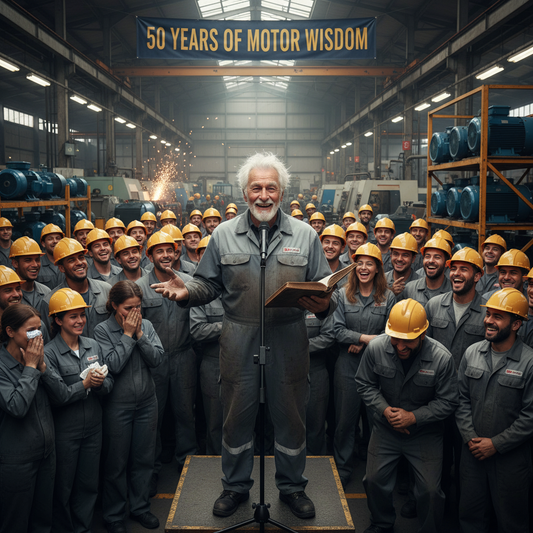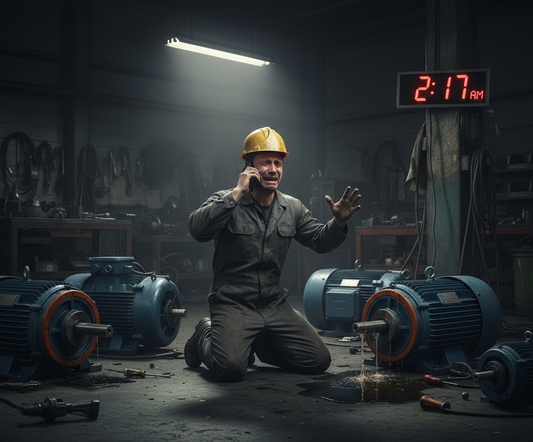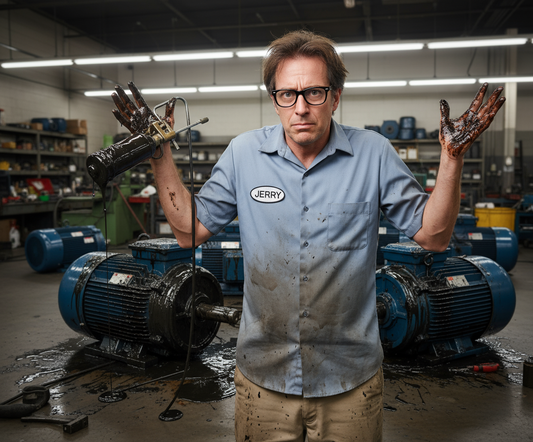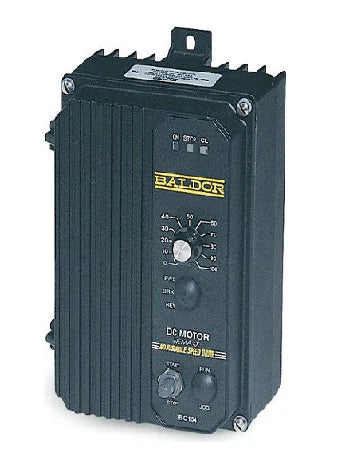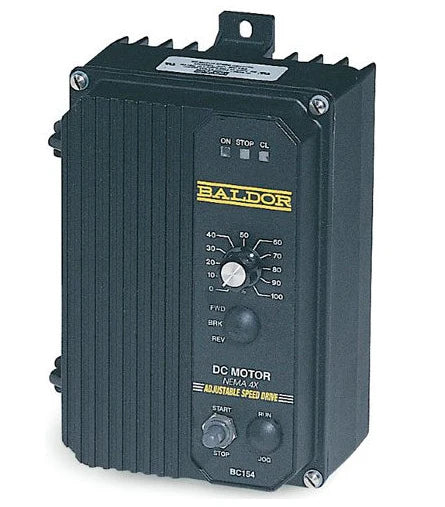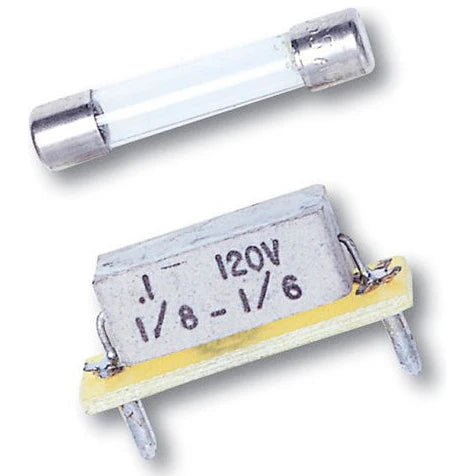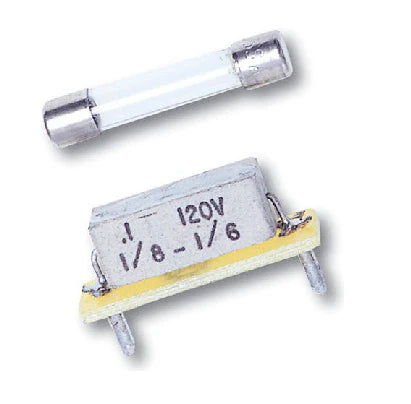
Share
I Rewound 10,000 Motors
So You Don't Have To
What actually happens behind the scenes (and why most rewinders suck)
← Missed Episode 1? Read: "Your Motor is Broken. Here's Why That's Actually Good News"
10,247 motors.
That's how many we've rewound since I started keeping track. Probably another 5,000 before that.
Every single one was someone's critical equipment. Every single one had a story. Some of those stories are hilarious. Most are expensive. A few are terrifying.
Today I'm going to show you exactly what happens when you hand us a dead motor. No secrets. No mystery. Just the actual process.
Because if you're going to trust someone to fix a $15,000 piece of equipment, you should probably know what they're actually doing with it.
What Actually Happens to Your Motor (The Real Process)
When your motor arrives at our shop, it doesn't go straight to "the rewind guy."
It goes through a diagnostic process that tells us exactly what's wrong and whether it's worth fixing.
Most shops skip this part. They just start tearing into motors like they're opening Christmas presents.
That's how you turn a $1,200 bearing job into a $4,500 full rewind.
Receiving & Documentation
Before we touch anything:
- Take photos of everything (including damage)
- Record nameplate data (HP, voltage, RPM, frame size)
- Note visible damage or modifications
- Check for missing parts (someone always loses the fan cover)
- Document how dirty/rusty it is (tells us about environment)
Why this matters: If you send us a motor that's already missing the junction box, we need to know that BEFORE we quote you. Otherwise you get mad when we charge you for a junction box you swear was there.
Electrical Testing (Before Teardown)
This is where we figure out what's actually wrong:
- Megger Test: Measures insulation resistance (should be >100 megohms for healthy motor)
- Resistance Test: Checks if all three phases have equal resistance
- Ground Test: Makes sure windings aren't touching the frame
- Continuity Check: Verifies no open circuits or breaks
Reality check: About 30% of motors that come in as "won't run" just have bad bearings or a loose connection. The windings are fine. We tell you this. Then you decide if you want us to fix just the bearings or do a full rewind anyway.
Mechanical Inspection
While it's still together, we check:
- Does the shaft spin freely? (or is it seized?)
- How bad are the bearings? (crunchy, loose, totally destroyed?)
- Is the shaft bent or scored?
- Any cracks in the frame?
- Are the fans intact?
- What's the coupling situation?
The Jerry indicator: If bearings are packed with grease like toothpaste in a tube, we know Jerry got to it. If they're completely dry, we know Jerry forgot about it.
Quote & Customer Decision
Now we call you with actual information:
- "Your windings are grounded - needs full rewind: $2,400"
- "Just bearings and it'll be fine: $650"
- "Frame is cracked, not worth fixing: buy new"
No surprises. No "we'll see when we get in there." Exact price. You decide.
Teardown
If you approve the repair, we disassemble everything:
- Remove end bells (the round parts on each end)
- Pull bearings off shaft
- Extract rotor from stator (the stationary windings)
- Document winding configuration before touching anything
- Take photos of how everything was connected
Critical: Before we burn out old windings, we record EXACT winding data - wire size, turns per coil, connection pattern. This data determines if motor runs correctly. Mess this up and you've built a very expensive boat anchor.
Winding Removal (The "Burn Out")
This is where bad shops ruin motors:
- Old windings get burned out in controlled oven (800°F for 8-12 hours)
- Temperature MUST be controlled (too hot = damage to core laminations)
- Time MUST be monitored (too long = core damage)
- Some shops use torches or uncontrolled ovens - this destroys the steel core
You can't see core damage from outside, but you'll see it in your power bill when efficiency drops 15%.
Core Preparation
After burnout, we clean and inspect the core:
- Remove all old winding remnants and varnish
- Inspect core for damage (overheating, contamination, rust)
- Test core for shorts between laminations (core fault test)
- Clean slots where new wire will go
- Install new slot insulation
If the core is damaged from improper burnout, we tell you. At this point it's still rewindable, just might not perform as well as before.
Rewinding
This is the skilled labor part:
- Wind new coils using exact wire size from winding data
- Form coils to fit into stator slots
- Insert coils into slots with proper insulation
- Connect coils in correct pattern (series, parallel, wye, delta - whatever original was)
- Lace and secure all connections
- Route leads to terminal box correctly
Time required: Small motor (5-10 HP): 4-6 hours. Large motor (100+ HP): 2-3 days. This is why rewinding costs what it costs - it's actual skilled labor.
VPI Treatment (Varnish Pressure Impregnation)
This is what makes the rewind last:
- Stator goes into vacuum chamber
- All air removed from between windings
- Epoxy varnish forced into every void under pressure
- Baked at 275°F to cure varnish
Why VPI matters: This varnish bonds all the windings together, prevents moisture, stops vibration, improves heat transfer. Motors without VPI fail faster. Period.
Cheap shops skip this step or use dip-and-bake (not the same). You save $200. Your motor fails in 3 years instead of 15.
Rotor Service
While stator is getting rewound, we handle the rotor:
- Inspect rotor bars for cracks or breaks
- Check end rings for damage
- Clean shaft journals (where bearings mount)
- Check shaft for bends, scoring, damage
- Dynamically balance rotor to 0.0005" (yes it matters)
Balancing truth: Some shops skip balancing. "It's close enough." Then they wonder why their rewound motors vibrate like paint mixers.
Bearing Replacement
Always replace bearings during rewind (unless they're massive $3,000 sleeve bearings):
- Press old bearings off shaft (if not done already)
- Clean bearing seats on shaft and in end bells
- Install correct bearings (by manufacturer part number, not "close enough")
- Heat bearings to proper temperature for installation
- Press onto shaft with proper alignment
Fun fact: The #1 way to ruin a new bearing is hammering it on cold. We heat them to 200°F first. They slide on perfectly, then shrink-fit to shaft as they cool.
Reassembly
Put it all back together:
- Insert rotor into stator (carefully - don't ding the windings)
- Install end bells with proper alignment
- Torque all bolts to specification
- Install fan, fan cover, junction box
- Wire terminal connections per nameplate
- Install nameplate (with updated data if needed)
Testing & QC
Every motor gets tested before it leaves:
- No-load test: Run motor uncoupled, check current draw
- Resistance test: All phases balanced within 5%
- Megger test: Insulation resistance >100 megohms
- Hi-pot test: Apply 2x rated voltage +1000V for 1 minute (proves insulation integrity)
- Vibration check: Should be smooth, no abnormal noise
- Temperature check: Should run cool under no load
If it doesn't pass all tests, we figure out why BEFORE it goes back to you.
Documentation & Delivery
You get:
- Complete test report with all measurements
- Photos of before/during/after
- List of everything we replaced
- Warranty certificate
- Updated nameplate data if anything changed
Total time: 3-7 days typically. Rush service available if you're willing to pay for it.
The Wildest Motor Failures We've Seen
After 10,000+ motors, you see some things.
Here are my favorites:
🔥 The Lightning Strike Motor
The call: "Motor won't start and smells like a campfire."
What we found: Direct lightning strike through the power line. Blew a hole the size of a golf ball through the winding. Melted the rotor bars. Welded the bearings to the shaft.
The fix: Complete rewind, new rotor, new bearings, new everything.
Cost: $8,500
What they should've had: Surge protection. Costs $400. Would've saved the motor.
Lesson: Lightning doesn't care about your budget.
💧 The Underwater Motor
The call: "Motor's making a sloshing sound."
What we found: Motor was mounted outdoors. Drain plugs were missing. It had been raining. Motor had approximately 2 gallons of water inside it.
The miracle: It was still running. Poorly, but running.
The fix: Drained water, dried it out, tested windings (somehow still good), new bearings, sealed it properly.
Cost: $850
Lesson: Drain plugs exist for a reason. Also, motors are tougher than you think.
🐭 The Mouse Motor
The call: "Motor smells terrible when it runs."
What we found: Family of mice had built a nest inside the motor. Between the windings. Using insulation they'd chewed off the wires. One mouse was still in there (not alive).
The damage: Chewed insulation on multiple coils, mouse pee everywhere, general biological disaster.
The fix: Full rewind. We charged hazmat rates.
Cost: $2,400 + therapy for the technician
Lesson: Screens exist for a reason. Use them.
⚡ The "It Was Fine Yesterday" Motor
The call: "Motor was running fine, then just stopped."
What we found: All three motor mounting bolts had come loose. Motor was literally bouncing on the base. Eventually vibrated so hard it broke all the wiring connections inside the junction box.
The real story: They'd been ignoring vibration for 6 months. "It always vibrates."
The fix: Rewired connections, tightened bolts, aligned motor properly (it was off by 0.030").
Cost: $450
Could've been prevented with: Literally just tightening the bolts.
Lesson: Vibration isn't normal. It's a warning.
🔧 The "Jerry Special"
The call: "Motor keeps overheating and tripping."
What we found: Someone (definitely Jerry) had "rewound" this motor himself. Wire size was wrong. Turn count was wrong. Connection pattern was wrong. It was impressive how wrong everything was.
The kicker: He'd written notes on the frame in Sharpie: "500 turns per coil" (should've been 48).
The result: Motor drew 3x rated current and produced about 30% of rated torque.
The fix: Complete rewind with correct data.
Cost: $3,200
What Jerry's "repair" cost them: 6 months of high power bills, multiple trips, production delays, and now a proper rewind anyway.
Lesson: YouTube is not a substitute for training.
I could do this all day. We've got hundreds of stories.
The theme? Most failures are preventable. And most "repairs" make things worse.
Why Most Motor Rewinders Suck (And How to Spot Them)
Not all motor shops are created equal.
Some are excellent. Some are adequate. Some are disasters waiting to happen.
Here's how to tell the difference:
🚩 RED FLAGS (Run Away)
They quote without testing
"Yeah, that'll be about $1,500 to rewind." How do they know? They haven't even tested it yet. Could be a $300 bearing job. Or could need a new rotor too. Real shops test first, quote second.
No documentation/testing provided
"We fixed it, here you go." No test results? No photos? No report? What exactly did they do for $2,000? Could be a great rewind. Could be garbage. You'll never know.
Suspiciously cheap pricing
"We'll rewind that 50 HP motor for $800." Cool. How? Proper rewind is 20+ hours of skilled labor plus materials. At $800 they're either skipping steps or lying about what they're doing. You don't get champagne at beer prices.
"We'll get to it when we can"
No timeline? No commitment? Your motor is sitting in a pile. Good shops track everything, give you actual dates, update you on progress.
No VPI equipment visible
If they don't have a VPI tank (big pressure vessel), they're dip-and-bake rewinding. This is 1970s technology. Works okay for non-critical motors. Sucks for anything important.
"Close enough" on winding data
"We use standard winding data." Cool story. Motors are built to thousands of different specs. Standard winding data is how you get a motor that draws wrong current and produces wrong torque.
They don't ask about your application
"What's the motor used for?" should be one of the first questions. If they don't care, they don't care if the rewind is right for your application. A pump motor and fan motor have different requirements.
What Good Shops Do Different
❌ Bad Shops
- Quote without testing
- No documentation
- Dip-and-bake varnishing
- Skip balancing
- "Standard" winding data
- No load testing
- Cheapest price wins
- No warranty or 30 days
- Can't explain what they did
✓ Good Shops (Like Us)
- Test before quoting
- Complete documentation
- VPI treatment standard
- Dynamic balancing
- Record actual winding data
- Full electrical testing
- Fair pricing, explained
- 1-year warranty minimum
- Can show you exactly what we did
Bad shops treat motor repair like an assembly line. Fast, cheap, move on to the next one.
Good shops treat each motor like critical equipment. Because it is.
Your production depends on this motor. We don't forget that.
What You Should Actually Pay for a Rewind
Pricing question. Everyone's favorite.
Here's the truth: Motor rewinds aren't cheap, but they're way cheaper than new motors.
Typical pricing (full rewind with bearings, VPI treatment, balancing, testing):
- 1-5 HP: $800-1,500
- 5-20 HP: $1,200-2,500
- 20-50 HP: $1,800-4,000
- 50-100 HP: $3,000-6,500
- 100-250 HP: $5,000-12,000
- 250+ HP: $10,000-25,000+
Compare that to new motor prices (similar HP ranges):
- 1-5 HP: $400-1,200 new (rewind usually not worth it)
- 5-20 HP: $1,500-4,000 new
- 20-50 HP: $3,000-8,000 new
- 50-100 HP: $6,000-15,000 new
- 100-250 HP: $12,000-35,000 new
- 250+ HP: $25,000-80,000+ new
Rule of thumb: If rewind costs less than 60% of new motor price, it's usually worth it.
Exception: Small motors (under 5 HP). Often cheaper to just buy new than rewind.
Also consider: Lead time. New motor might be 6 weeks out. Rewind is 5 days. Downtime costs matter.
The Winding Data Mystery (Solved)
This is the part that confuses everyone.
"How do you know what wire to use? How many turns? What pattern?"
Three ways:
Before we burn out old windings, we document everything:
- Wire size (AWG gauge)
- Number of turns per coil
- Number of coils
- Series or parallel connection
- Wye or delta configuration
- Pitch (how coils are positioned)
This is exact. This is how motor was originally built. This works every time.
Some manufacturers publish winding specs. We have databases of common motors.
Problem: Motors get modified, updated, substituted. Database might be for different year/revision.
We use this as backup/verification, not primary source.
If motor is totally destroyed and we can't find data, we can calculate winding design from nameplate specs.
Problem: Gets you close, but might not be exact. Motor might run slightly different than original.
We only do this if customer approves and understands the limitations.
Bad shops use Method 3 for everything. "We'll just calculate it." Then they wonder why motor draws 110% current and trips the breaker.
Got a Dead Motor?
We'll test it, tell you exactly what's wrong, quote you a fair price, and show you our work.
📞 Call: (720) 626-9805Same-day pickup in Denver metro. 3-7 day turnaround. 1-year warranty.
The Thing About Trust
Here's what I've learned after 10,000+ motors:
People don't understand motor repair. They just need to trust someone who does.
You can't look at a rewound motor and tell if it's done right. The windings are hidden under varnish. The core damage is invisible. The testing happens before you get it back.
You're trusting us to:
- Actually test it properly
- Quote you fairly
- Use correct winding data
- Not damage the core during burnout
- Install the right bearings
- Balance it correctly
- Test it thoroughly before delivery
That's a lot of trust.
Which is why we document everything. Take photos. Provide test results. Explain what we found and what we did.
Because trust without verification is just hope.
And hope is not a maintenance strategy.
Call us: (720) 626-9805
We do shop tours. Come see exactly what we do with your motors. (Jerry not included.)
One Last Thing
If you take nothing else from this essay, remember this:
Motor repair is skilled labor. It takes time. It costs money. But it costs way less than replacing good motors with new ones.
The shops that do it right charge fair prices and explain their work.
The shops that do it cheap skip steps and hope you don't notice.
Choose carefully. Your equipment depends on it.
Call Us: (720) 626-9805
Colorado Electric Motors
10,247 motors rewound and counting.
P.S.
Yes, those motor failure stories are all real.
Yes, Jerry is a composite character based on dozens of maintenance technicians.
No, we're not mad at Jerry. We understand. Training is expensive.
But so are motor failures.
P.P.S.
The mouse motor still haunts me.
If your motor smells weird, call us immediately.
Don't wait to find out why.
📺 NEXT EPISODE
"The $47 Test That Saves $47,000"
Coming in 2 days... (Megger testing explained with no boring parts)
